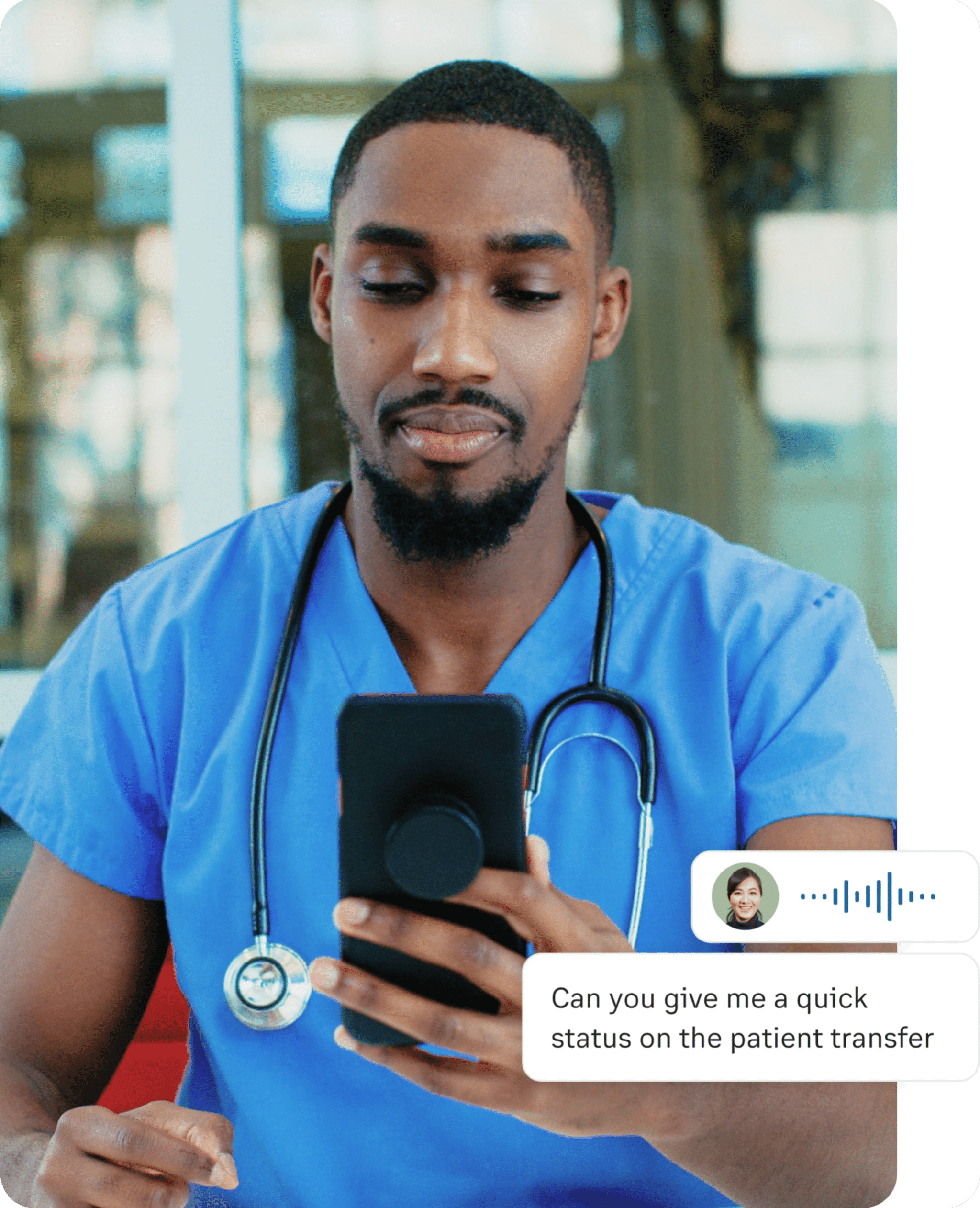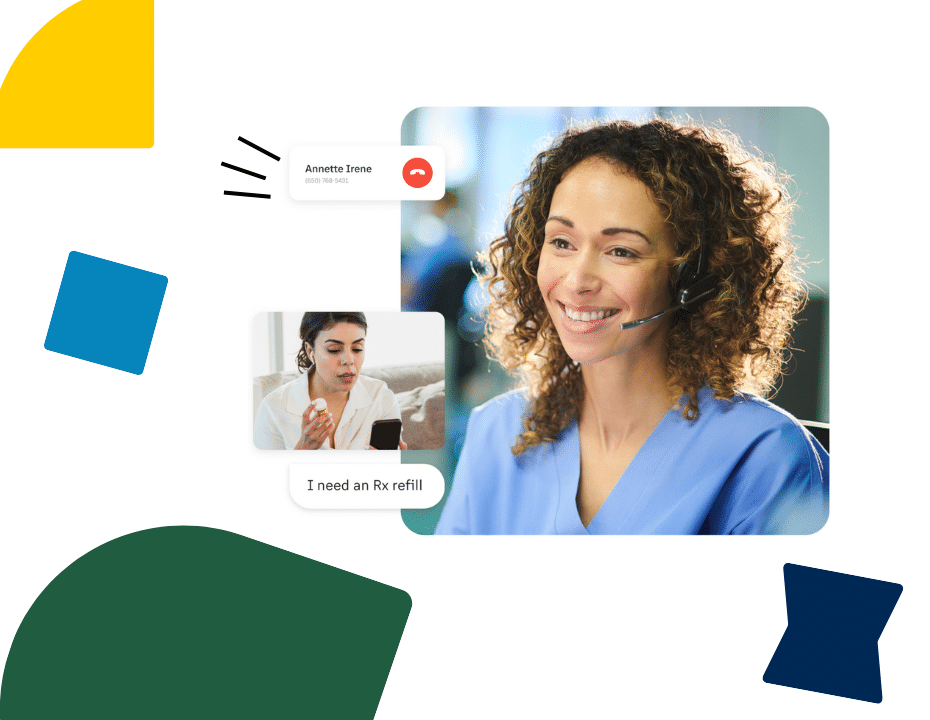Highlights:
- Healthcare leaders say collaboration is critical for improving the patient experience
- Seamless patient care requires tools that empower all levels of employees, from admins to clinicians, to address patient needs quickly and flexibly
- Among the impressive results from collaboration-enabled care: RingCentral customers have shrunk patient call times by 30% and provide innovative new channels for patient care
Timely access to appointments, helpful information, multidisciplinary teams that work well together—there are many things that together make for a great healthcare experience for patients. But at the heart of it all is collaboration.
 Free eBook
Free eBook
Read how cloud communications transformed one woman’s healthcare journey from pain and uncertainty to healthy and informed.
A whopping 87% of healthcare leaders say collaboration improvement is one of their top three priorities as an organization.
But how can better collaboration (and better collaboration tools) optimize the patient experience? Here are some of the key takeaways from our session.
1. Better scheduling is the first step
Accessibility is one of the most important pillars of healthcare. But between a high volume of patients trying to make appointments to more admins and call center reps working remotely, it’s also the first place a healthcare organization can fall short of providing the ideal experience.
But smarter, more advanced features, such as those of RingCentral MVP, can help to improve this first step on the healthcare journey.
What does better scheduling look like in action?
- Call queue features that recognize an existing patient’s phone number when they call in, and automatically route their calls to an intake coordinator or scheduler.
- Head-up display (HUD) that brings essential features—like the ability to quickly consult on appointment availability with a specialist team in real time—into the mobile experience, improving remote scheduling.
- Automated MMS messaging and communications to enable patient reminders about the appointment.
2. Seamless provider handoffs
Great healthcare involves numerous care providers—and to deliver the best experience, the individuals need to be able to communicate and work together seamlessly.
Consider, for example, how care is administered on hospital floors. Providing 24/7 patient treatment requires collaboration between mobile healthcare providers who may be on another floor or in another patient room when a question arises. It also requires the seamless handoff of information between shift workers such as nurses and ER doctors.
Ruggedized handset devices loaded with the RingCentral app deliver on the need for seamless mobility:
- Hot-desking allows devices to be securely shared and handed off to the next shift. Users can log in and access all their voice messages, contacts and more.
- Head-up display provides information about the active status and availability of other key members of care teams, such as the nurse manager.
- Full suite of communication tools, including video, means providers can consult with other teammates and provide multidisciplinary care without leaving the patient’s bedside.

3. Consider the full spectrum of the patient journey
The patient experience doesn’t end at your office door. Often, the best outcomes for patients are determined by what comes next: how well they are able to comply with clinicians’ recommendations or get answers to questions.
But timeliness and access can again be an issue. The right collaboration tools can improve clarity and resolve potential bottlenecks:
- Automated voicemail transcription to speed internal communications and respond to follow-up questions or other needs faster.
- Powerful video conferencing capabilities to reduce the need for in-person follow-up.
- AI-driven tools such as autoframing for optimal viewing of telemedicine appointment participants, improving the remote follow-up care experience.
Collaboration-enabled care: Real-world outcomes
Video: Hear from ENT and Allergy about their experience transitioning to RingCentral
The power of better collaboration tools to drive the ideal patient experience is more than just theoretical.
Take ENT and Allergy, an ear, nose, and throat specialist with 45 locations and 226 doctors in New York and New Jersey. The organization handles about 40,000 calls a week—and had to reinvent how phone communications were handled when reps had to work remotely during COVID-19.
ENT’s previous VoIP solution proved to be an obstacle: it involved bulky equipment and antiquated software with limited functionality and visibility into employee performance and productivity.
A seamless weeklong rollout later, and ENT was able to transform its call center capabilities with RingCentral: they were able to expand call center operations by bringing on more remote reps, including a late shift on the west coast to expand call hours. And thanks to improved workflow efficiencies, access to information, and more sophisticated call routing capabilities, they also shrunk call times by 30%.
The improvements won’t stop there. ENT actively uses RingCentral’s robust analytics to keep identifying new opportunities to improve their service delivery, and are exploring RingCentral’s self-service call capabilities, to empower patients to bypass live agents and book their own appointments using an automated system.
Ideal patient experiences start here
While better collaboration tools are already delivering huge improvements to the patient experience—and helping healthcare organizations weather ongoing COVID-related challenges—we’re just beginning to deliver on the potential.
Better healthcare outcomes at a lower cost. Cloud communication systems are transforming healthcare. Find out how.
Originally published Dec 16, 2022, updated Jul 26, 2024





